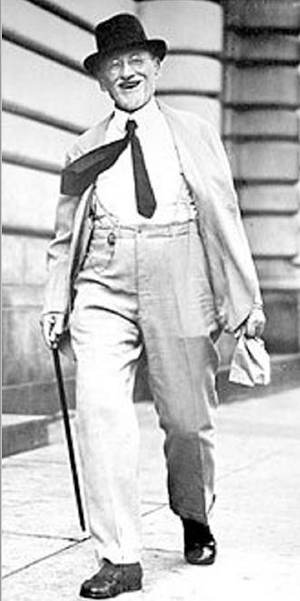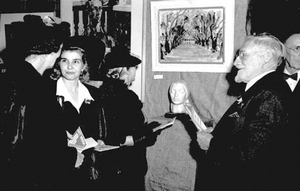Most Galvestonians are familiar with the story of Dr. Isaac Cline,
the meteorologist who headed the Island’s
weather office during the 1900 Storm. As famous as that chapter of this life
was, few know what became of him afterward.
Prior to arriving in Galveston, Cline had already established a reputation as a
gifted forecaster, even founding the Abilene
weather station in October 1885. In March of 1889, he and his wife and children
moved to Galveston,
a city to which his name would forever be linked. One month later, he
successfully predicted the rupture of the Colorado River dam in Austin, saving countless
lives.
 His skills were not
infallible, however. A delay in grasping the imminent danger posed by the
September 1900 hurricane resulted in failure to receive cooperation from the
central Weather Bureau office in Washington D. C. to declare a state of
emergency to the public. In desperation and against instruction from his
superiors, Cline rode along the beach and lower elevations in a buggy to warn
residents to move to higher ground before returning to his own home and family.
Unfortunately many did not heed his warnings, because the weather in the hours
previous to the storm had been especially beautiful.
His skills were not
infallible, however. A delay in grasping the imminent danger posed by the
September 1900 hurricane resulted in failure to receive cooperation from the
central Weather Bureau office in Washington D. C. to declare a state of
emergency to the public. In desperation and against instruction from his
superiors, Cline rode along the beach and lower elevations in a buggy to warn
residents to move to higher ground before returning to his own home and family.
Unfortunately many did not heed his warnings, because the weather in the hours
previous to the storm had been especially beautiful.
Storm waters rose in
Cline’s home, like so many others across the Island,
but although he and his brother were able to heroically save his children,
Cline’s pregnant wife was killed by falling debris. She is buried in Galveston’s Lakeview
Cemetery.
New
Orleans
The National Weather
Bureau went through major changes after the turn of the 20th
century, establishing the first regional weather forecast centers outside of
the headquarters in Washington,
D.C. A San
Francisco center was charged with forecasting for the Pacific Coast,
and a Chicago location for the Great Lakes and
the Midwest. The final addition was in charge
of the Gulf Coast,
initially comprised of Texas and Oklahoma but soon expanded to include Louisiana,
Arkansas, Mississippi,
Alabama and Northern
Florida.
Isaac Cline was selected
to head this last station which was originally located in Galveston. The new position raised his annual
salary from $200 to $2000.
Under pressure from Louisiana officials, Weather Bureau Chief Willis L. Moore
quietly transferred the office to New
Orleans. Had publicity been allowed prior to the move,
the powerful Texas
congressional delegation at the time would most likely have moved to stop it.
Many people, Cline included, felt that his transfer to New
Orleans was a punishment for independent actions during the Galveston hurricane and because Moore felt his position as bureau chief was
threatened by Cline’s forecasting abilities.
In early August 1901,
Cline and his three daughters Rosemary, Allie, and Esther moved to the Crescent City, where he would serve as district
forecaster and eventually the principal meteorologist. One year later, he
married Margaret C. Hayes, and he and his daughters moved into her home on Prytania Street.
Disaster Averted
Luckily for Louisiana, Cline brought an expertise in flood
forecasting to New Orleans.
As soon as he arrived in the city, he established a study of flood causes and
conditions to create a baseline to more accurately identify circumstances that
would cause such disasters.
In February 1903, his
studies were put to the test when heavy rains foretold dangerous conditions on
the Mississippi River. On March 9, without
permission of the bureau chief, Cline issued warnings of an impending record
flood stage of 21 feet in New Orleans
during the following three to four weeks, and encouraged the construction of a
temporary levee extension.
He was ordered by
superiors to lift the warnings but refused, responding, “Is it not better to
warn people of approaching disaster sufficiently in advance to enable them to
prepare to meet it than to let them be caught unprepared?”
Cline’s decision saved
lives. Flood waters rose to 20.7 feet, a height other experts had denied were
possible, and the levee broke. The disaster would surely have been worse
without Cline’s warnings, and the public celebrated him.
His supervisors
conveniently failed to mention this fact in damage reports after the event.
Instead, they planned to remove Cline from his position to save embarrassment
on their part. Nine months later, Cline received an official communication that
his forecasts were not up to acceptable standards and as a result, he was being
transferred to Honolulu.
Only the intervention of the Louisiana
congressional delegation saved him from the transfer.
In March 1913, Bureau
Chief Moore resigned under pressure and was replaced.
Another Hurricane
Among Cline’s most
successful forecasts was that of an approaching hurricane in 1915. This
particular storm possessed the highest wind velocities yet measured on the Gulf Coast:
140 miles per hour. Nearly every building in New Orleans sustained damage, but
surprisingly, only 279 lives were lost, many of those at sea, thanks to the
Bureau's storm warnings.
After the storm, the New
Orleans Times-Picayune commented, "The intensity of the
storm...proved the worthiness of Dr. I.M. Cline...Never before, perhaps in the
history of the Weather Bureau, have such general warnings been disseminated as
were sent out by the local bureau in reference to the disturbance that passed
over New Orleans Wednesday evening." Cline was achieving hero status in
the Mississippi Delta.
Great Mississippi
Flood
Cline's final great
professional achievement came when he successfully predicted flood stages two
weeks prior to the Great Mississippi Flood of 1927, one of the greatest floods
in American history.
The meteorologist became
furious when his warnings were not printed in the local papers, and called
reporters into his office to explain. He learned that publishers refused to
print them due to pressure over concern of bad publicity for New Orleans commerce.
Despite the available
knowledge that the city may be in the path of one of its greatest disasters,
few citizens knew about the danger. Cline approached the local censorship
committee, threatening that if they did not release the warnings through the
press he would use other channels to distribute them. The move succeeded in
getting the warnings posted.
As a result of his
insistence, the New Orleans Item
Tribune printed an article on July 3 entitled "Doctor Cline, Unsung
Hero of Big Flood." In it, Secretary of Commerce Herbert Hoover referred
to Cline as a genius.
"Too much credit
cannot be given Dr. Cline for the work he has done. His flood forecasts have been
absolutely uncanny in their accuracy, he has without a doubt saved the lives of
thousands of people with these bulletins."
 Love Of Art
Love Of Art
From the time he moved to New Orleans, Cline began
pursuing a collection of art and antiques and spending his free time restoring
them. In his memoir entitled “Storms, Floods and Sunshine” he shares, “Choice
paintings and other works of art appealed to me. I bought paintings,
porcelains, bric-a-brac, and small pieces of furniture soon after my arrival…as
a hobby.” He often broke up his annual leave time into half days, enabling him
to attend local auctions and estate sales.
Local families who wanted
to dispose of old family art collections often went to Cline first, due to his
reputation for fair pricing. He restored many of the paintings himself, and
resold them to make money to purchase others.
Their shared love of art
was probably largely what drew Cline and his second wife to each other. Having
amassed a sizable collection of her own before their marriage, the probate of
her will in 1928 listed specific instructions concerning several artists’
works. She willed her extensive collection of paintings to her brother and
sister with the exception of her paintings by Keith, which went to Cline.
In 1929, Cline found a
portrait of Abraham Lincoln by Frank Carpenter in an obscure repository of
antiques in Washington.
After purchasing it, he acted on what he referred to as a “hunch” and carefully
scraped off excess paint applied to the surface of the piece by an unknown
artist. His restoration resulted in one of the best-known portraits of Lincoln which he then loaned to the Cabildo in New Orleans.
The Art House
His remaining years with
the Bureau were comparatively quiet, but he retained a place of respect in the
community. It is said that locals used to watch the grey-haired gentleman walk
from his home in the French Quarter to the bureau office to see if he carried
an umbrella. Local lore credits him with the saying, “Don’t put rain in the
forecast until it starts, and don’t take it out until it stops.”
At age 75 in 1935, Cline
petitioned to extend his career, but was forced to retire after 53 years of
service. He was fond of saying that he was older than the Weather Bureau.
Though he begrudgingly accepted retirement, it provided him with the time to
dedicate to his love of art. In 1936 he opened a small art and antique shop at 633 St. Peter Street
in the French Quarter called “The Art House.”
Specializing in Early
American portraits and Chinese bronzes, the pursuit made him a wealthy man. In
addition to collecting artwork, he continued his work restoring paintings and
antique glassware in the studio as well. Cline was the first to admit that his
hobby was as much inspired by the connections it provided him to the upper
levels of society as the sheer love of the work itself. He became a fixture of
the French Quarter, known for his warm smile and welcoming handshake.
The scientist did not
leave his dedication to weather entirely in the past. In addition to continuing
his meteorological work, he published a scientific monograph entitled “A
Century of Progress in the Study of Cyclones.” It was considered one of the
most important works of its kind at the time.
In 1953, Cline became very
ill and had to sell his beloved Art House. Dr. Isaac Cline passed away on
August 3, 1955 at the age of 94 as a new hurricane approached the gulf. His
brother Dr. Joseph L. Cline, who survived the 1900 Storm by his side, died five
days later.
Dr. Isaac Cline is buried
in Metairie Cemetery
in New Orleans
in a plot belonging to the family of one of his daughters. No headstone bears
his name or hints to the incredible man who rests there.